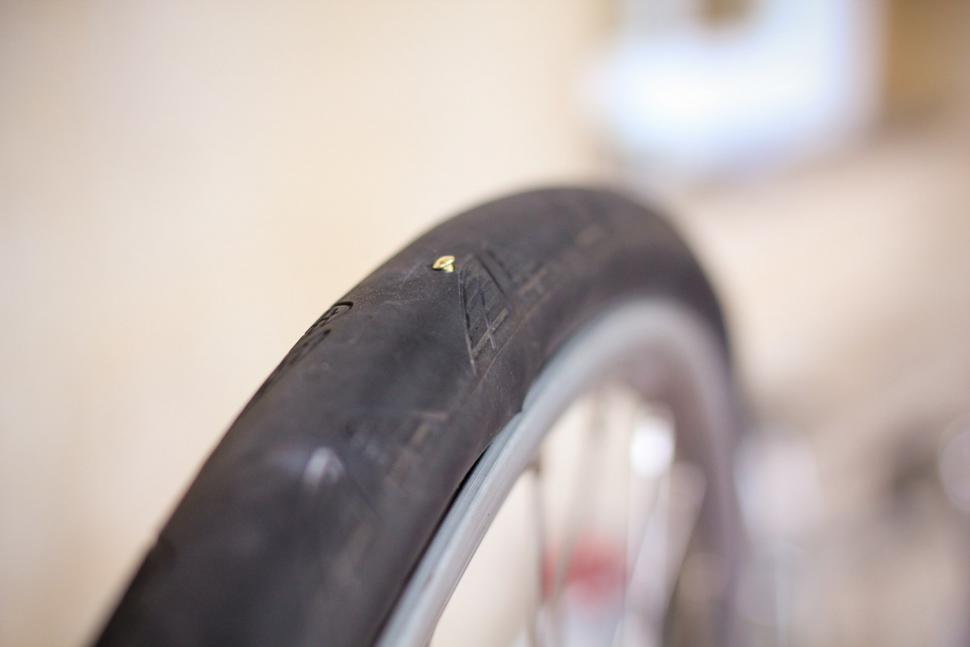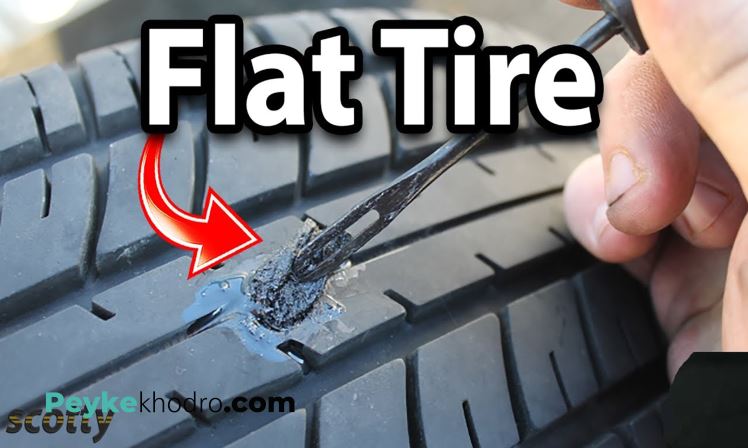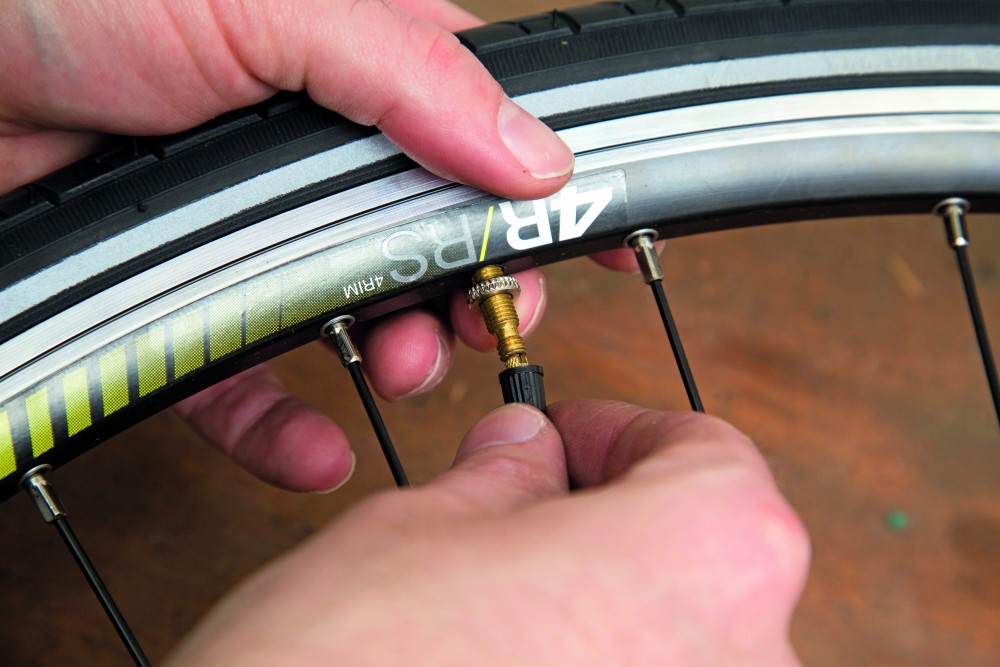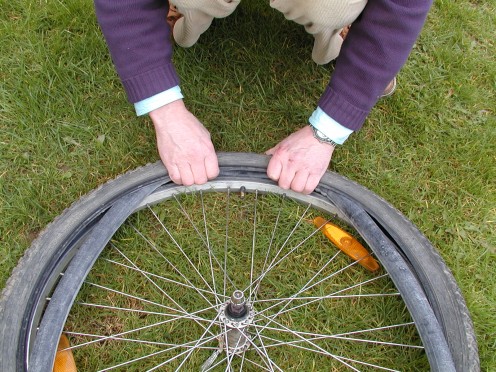So, you have a flat tire or one that’s leaking air. It’s not the end of the world. Luckily there are safe and cost-effective ways to properly repair most tire punctures. The purpose of this article is to show you the difference between a safe, permanent repair and a temporary string, plug or patch repair.
According to the National Highway Traffic Safety Administration (NHSTA) and the Tire Industry Association (TIA), the only method to properly repair a tire puncture is to fill the injury with a repair stem and back the stem with a repair patch. This is commonly known as a combination repair or a patch/plug repair.
Patch/plug repairs are most often performed using a one-piece repair unit that combines the repair stem and cap (or patch) into one unit. However, special circumstances may require the use of a two-piece combination repair (ex. If the angle of the puncture exceeds 35 degrees). The repair is then permanently bonded to the inside of tire and through the injury channel using a cold, chemical vulcanizing process.
The repair essentially becomes part of the tire, creating an air-tight seal that keeps air in and moisture and contaminants out (more on this procedure below).
Emergency roadside plug repairs are NOT intended to be a permanent tire repair. Plugs and string repairs are designed to get you back up and rolling long enough to get home or to the nearest service center to perform a proper tire repair.
The common misconception with plug and string repairs is that because they hold air, they are safe to use. While it is true that many plug repairs do a great job of keeping air in the tire, that’s only part of the equation. Because they’re not completely sealing the injury, plug repairs may allow air and moisture to penetrate the body of the tire. Over time, this could lead to a dangerous (or even deadly) blowout.
A Patch-Only Tire Repair Leaves Your Tire Susceptible to DamageA tire repair that uses only a patch is also NOT considered proper or safe. A properly installed patch will do a great job of allowing the tire to hold air. However, similarly to the plug-only repair, the patch does not fill the injury channel. Therefore, air and moisture could seep into the tire from the tread surface and eventually damage the tire.
A properly installed patch will do a great job of allowing the tire to hold air. However, similarly to the plug-only repair, the patch does not fill the injury channel. Therefore, air and moisture could seep into the tire from the tread surface and eventually damage the tire.
Only a proper patch/plug repair completely seals the puncture from inside the tire and through the entire injury channel. There are a few extra steps necessary to perform a proper tire repair in accordance with industry guidelines. We’ve developed a simple acronym to help organize and remember the steps: R.E.P.A.I.R.
 It can also be determined if the puncture did any significant damage to the cords or belts.
It can also be determined if the puncture did any significant damage to the cords or belts. The over-buffed area of the inner liner is treated with a thin layer of rubber sealant, and the excess repair is trimmed to approximately ¼” above the tread surface.
The over-buffed area of the inner liner is treated with a thin layer of rubber sealant, and the excess repair is trimmed to approximately ¼” above the tread surface.There are a number of factors that may determine whether or not your tire is safe to repair. These factors fall into three main categories:
 Excessive wear, casing separation, impact damage and other conditions may make it unsafe to properly repair your tire. For a more comprehensive list of repairable vs. non-repairable conditions visit our blog Can Your Tire Be Repaired?
Excessive wear, casing separation, impact damage and other conditions may make it unsafe to properly repair your tire. For a more comprehensive list of repairable vs. non-repairable conditions visit our blog Can Your Tire Be Repaired?The occasional flat or leaky tire is an unavoidable part of life. But, taking shortcuts to repair it can be dangerous to you and your passengers. Take the time and do the research to do the job right and/or find a reputable tire repair shop trained in proper tire repair procedure.
By Cheryl Knight
Writer
Updated on Apr 27, 2022
Reviewed by Carrie Adkins, VP of Content.
Knowing how to properly repair a punctured tire can save you money, as well as keep you from being
stranded
on the side of the road.
Luckily, a couple of easy-to-follow methods exist for repairing a punctured tire.
While you should ultimately have your tires inspected and replaced if necessary following a tire repair, the methods below provide a great temporary fix to a punctured tire until you can get to a tire store.
Here's how to plug and patch a tire.
RECOMMENDED
No spam or unwanted phone calls · No long forms · No fees, ever
ZIP Code
ZIP Code
Find insurance savings (100% Free)
Using a tire plug to repair a punctured tire
A tire plug kit helps patch a tire quickly and easily. Considered a safer alternative to patches and sealant, a tire plug actually inserts into the tire. It then expands to plug any holes.
Here are the steps for how to plug a tire.
Step 1: Remove tire. Start by removing the punctured tire.
Step 2: Pull out object. Pull out the object that punctured the tire.
Step 3: Clean hole. Clean the puncture hole using a rasp tool, which you can find at brick-and-mortar stores like The Home Depot and Advanced Auto Parts.
A tire plug kit should contain various tools, one of which is a rasp tool.
The rasp tool can help the plug hold by roughening the tire material in the hole where you want to place the plug.
Step 4: Apply adhesive. Apply the adhesive that came with the tire plug kit.
Common adhesives include rubber cement or some other type of glue.
This glue can initially help lubricate the puncture hole, making it easier to get the plug through.
Step 5: Insert plug. Using the insertion tool, which also comes with your kit, insert the plug into the puncture hole.
While difficult to insert in some cases, you can get the plug to fit by squeezing down one of the end of the plug material.
Once the adhesive has dried, cut away any excess material from the plug using a razor or knife.
Step 6: Place air in the tire. Fill the tire to the recommended air pressure, which you can find inside the wall of the tire or in the owner's manual.
Test the seal of the tire plug by squirting a soap/water mix on the puncture area.
If needed, apply more adhesive or try using another plug.
Using tire sealant to repair a punctured tire
Flat tire sealant, such as
Fix-a-Flat
, provides a fast and easy way to fix a punctured tire—as long as the puncture is not too large. You should have the tire professionally repaired or replaced if the puncture is larger than one-quarter inch.
The following steps walk you through the process of using sealant to patch your tire.
Step 1: Remove the object. First, remove the object that punctured your tire.
Step 2: Position the tire. Position the tire so that the valve stem rests at the top of the wheel.
Remove the valve stem cap.
Step 3: Attach tire sealant nozzle. Attach the nozzle from the tire sealant can to the valve stem.
Press the button releasing the sealant into the tire.
Step 4: Drive the car. Drive the car around until the sealant has spread evenly throughout the tire.
This step is necessary to keep the sealant from forming a lump in one area and unbalancing the tire.
Step 5: Replace the tire. Make sure to replace the tire within a certain time limit.
Sealants are only meant to get you to where you can get the tire replaced. Most sealants only last for 100 miles or three days.
To minimize the chances of a punctured tire, try to avoid driving over potholes and other rough areas in the street, as well as on the side of the road where debris collects.
Even given your best efforts, a punctured tire is bound to happen. And when it does, you can use one of the above methods to fix it on the spot. Just remember to take your car to a professional tire shop to have the punctured tire inspected for safety, and replaced if necessary. And don't forget to keep an eye out for
Just remember to take your car to a professional tire shop to have the punctured tire inspected for safety, and replaced if necessary. And don't forget to keep an eye out for
slow leaks
.
If your tires were damaged in an accident or another covered peril, you should contact your insurance company.
Jerry
is the easiest and most effective way to find a car insurance policy that is customized for you.
After providing you with a comprehensive cross-analysis of the best policies across providers, Jerry will handle the phone calls, paperwork, and renewals for your top pick so that you don’t have to. They even help cancel your old policy! So why do all that extra work when Jerry can do it better?
RECOMMENDED
Judith switched to Progressive
Saved $
725
annually
Alexander switched to Travelers
Saved $
834
annually
Annie switched to Nationwide
Saved $
668
annually
02/22/2018
Despite the objective importance of the spare tire, not all drivers always have it with them. Some do not carry a spare tire out of hope or belief that their tires are invulnerable. Others deliberately take this step, as they stocked up with a special tool in advance, which, if necessary, can eliminate a tire puncture along the way. What else can be used and how to do it right? Let's figure it out.
Some do not carry a spare tire out of hope or belief that their tires are invulnerable. Others deliberately take this step, as they stocked up with a special tool in advance, which, if necessary, can eliminate a tire puncture along the way. What else can be used and how to do it right? Let's figure it out.
Contents of :
Conventionally, all methods for express tire repair can be divided into two categories:
Consider ways to restore a damaged tire on the road. The first three methods are temporary. The latter, with the right approach, allows you to completely restore the tire.
 e. preventive). A special sealing compound is pumped into all four undamaged tires. While driving, it is inside the wheel in liquid form. If the tire suddenly loses its tightness, then this composition, leaving together with the air, clogs the slot in a few seconds. This method is relevant if you have a long trip under time constraints.
e. preventive). A special sealing compound is pumped into all four undamaged tires. While driving, it is inside the wheel in liquid form. If the tire suddenly loses its tightness, then this composition, leaving together with the air, clogs the slot in a few seconds. This method is relevant if you have a long trip under time constraints. 
After removing the foreign object, the hole is processed with an awl with abrasive edges: this tool must be inserted into the puncture and cleaned and developed with intensive reciprocating movements several times. Then the raw rubber tow is removed from the package and inserted into the eye of the second awl so that both ends are the same length. The hole in the tire and the raw rubber is treated with an activator. Next, the awl is inserted into the puncture in such a way that small ends of the tourniquet, about a centimeter long, remain outside. After 5 minutes, the excess remaining on the surface is cut off. This method can also successfully eliminate small side cuts.
Then the raw rubber tow is removed from the package and inserted into the eye of the second awl so that both ends are the same length. The hole in the tire and the raw rubber is treated with an activator. Next, the awl is inserted into the puncture in such a way that small ends of the tourniquet, about a centimeter long, remain outside. After 5 minutes, the excess remaining on the surface is cut off. This method can also successfully eliminate small side cuts.
There is a technique that allows using wire and several bundles of raw rubber to get rid of even extensive side damage to tires. However, it is quite difficult to implement and not every driver will be able to implement it.
Consider a few well-known tools that are most widely used to repair punctures:
 It works in the same way as most sealants: the container is thoroughly shaken, after that a hose is attached, and the contents from the container are completely pumped into the tire. The maximum diameter of the repaired hole is 4.5 mm. This is almost always enough to repair punctures caused by nails and screws.
It works in the same way as most sealants: the container is thoroughly shaken, after that a hose is attached, and the contents from the container are completely pumped into the tire. The maximum diameter of the repaired hole is 4.5 mm. This is almost always enough to repair punctures caused by nails and screws.

Our online store offers a wide range of tire repair products. You can order them through the TopDetal.ru website or by calling 8 800 444-75-16.
Also read on our website about the best liquid rubbers.
Return to the list sharp debris accumulated over the winter under a layer of snow.
As a result of a puncture, the pressure in the tire decreases, and then the driver sees a corresponding signal on the instruments of his car.
It often happens that you can’t get to the nearest service with such damage, so you have to repair the wheel on your own using improvised means. Let's tell you how it's done.
In case of any damage to a car tire, it is important to act in accordance with a clear algorithm of operations. It is equally important to choose the most suitable flat tire repair option. Experienced car owners usually know what to do, and newcomers in most cases are lost.
Experienced car owners usually know what to do, and newcomers in most cases are lost.
If you find that the car has a flat tire, park on the side of the road, turn on the emergency gang, assess visibility and put an emergency stop sign at a distance of 15 m from the car - in the city, 30 m - on a country road.
According to the rules of traffic rules, a punctured wheel can be considered the reason for stopping in a prohibited area, but you should not abuse it. Usually with this damage you can drive 20-30 meters and stop in a safer place. Don't forget to take into account the amount of space on the side of the machine that is needed to clear a wheel puncture. Following the voice of reason (and the Rules of the Road), wear reflective clothing at night or when visibility is poor.
In order to cope with the problem of rubber puncture on your own, you need to purchase a repair kit at a car dealership and always have a repair kit with you. It contains thread-reinforced cords, glue, a round rasp with notches, an abrasive awl with a holder, or a needle for installing a tourniquet. Pay attention - too "toothy" awl can break the cord threads, and its task is to push them a little.
Pay attention - too "toothy" awl can break the cord threads, and its task is to push them a little.
Separately, purchase a sealant, a sharp knife, a screwdriver and pliers. With such an arsenal, in most cases you will be able to repair the damage without disassembling and removing the wheel.
If a nail gets into the wheel, then the puncture site is not always visible to the naked eye. To find it, you need to listen - the air leaves the tire with a low hiss. You can also apply a soapy solution to the wheel and find a place where bubbles will inflate. Instead of a soapy solution, you can water the protector with plain water and watch for the appearance of bubbles.
Tire repair with a patch consists of the following steps:

The best patches are produced by Maruni, Rossvik and Tip-Top. They use special thick rubber.
Instead of a patch, you can put a flagellum made of raw rubber, which will serve as a miniature patch. It is included in the repair kit. Here's how it's done:
How to properly store tires
How to choose tires for your SUV

The advantages of such a repair are simplicity, low cost and decent reliability. It allows the tire to be used at least until the end of the season. But there are also disadvantages. For example, when installing a harness, you can damage the cord. Therefore, if possible, it is better not to enlarge the hole, but, having pumped up the tire, drive to the nearest car service.
You can repair a punctured tire with a liquid aerosol sealant, which is sold in cans. We take out the object that has fallen out of the tire, pour the sealant through the valve and scroll the wheel so that the product is distributed inside the rubber. After that, we pump up the wheel and drive 4-5 kilometers at low speed. So the sealant is finally evenly distributed inside the tire.
This method is easier than repairing a puncture with a patch or flagellum, but the sealant will not cope with a hole that is too large. Another disadvantage is the possibility of wheel imbalance.
Another disadvantage is the possibility of wheel imbalance.
If you punctured a tire, found a puncture, and there were no foreign objects in it, and you don’t have a repair kit or a spare wheel, you can use the “folk” method. Find a self-tapping screw (if not, unscrew it from some part in the cabin) and screw it into the puncture up to the very head , as in a plastered or wooden wall. A tightly screwed self-tapping screw will be able to maintain pressure, and use a sealant to repair minor damage inside the rubber. Of course, this will not make the wheel completely sealed, but it will give time to get to the nearest service. And in the best scenario with such a repair, you can drive up to a month, periodically pumping up the wheel when the tire pressure drops below 1.5 atmospheres.
It is better to inflate a completely flat tire without a spool, since when air is injected, resistance to the pump occurs. And the absence of this part allows the air flow to increase, which, on the contrary, facilitates the operation of the compressor.